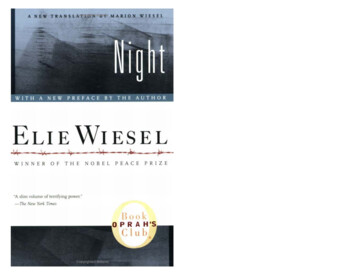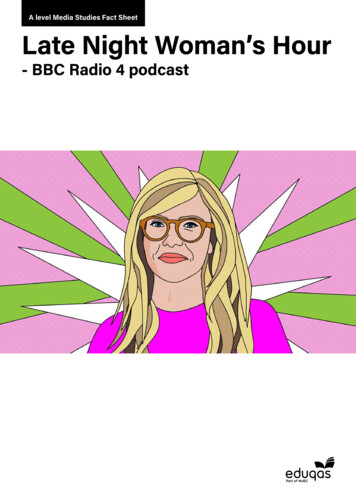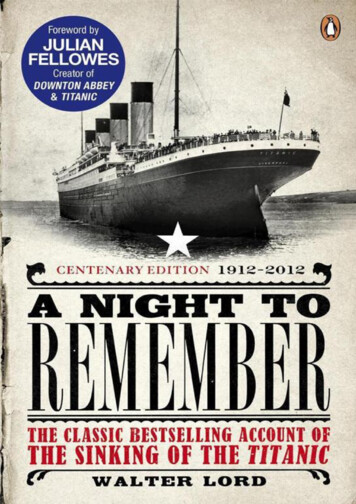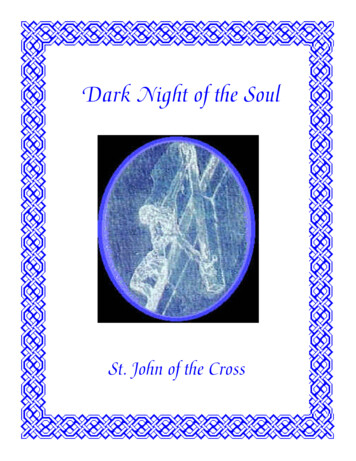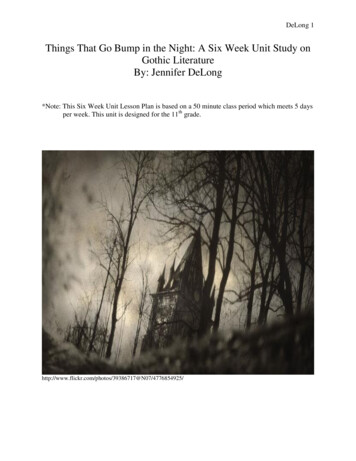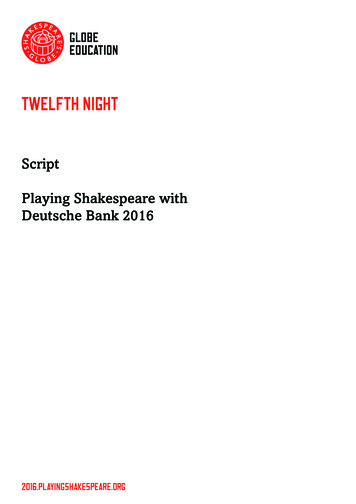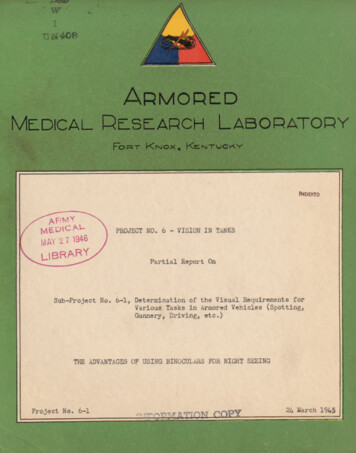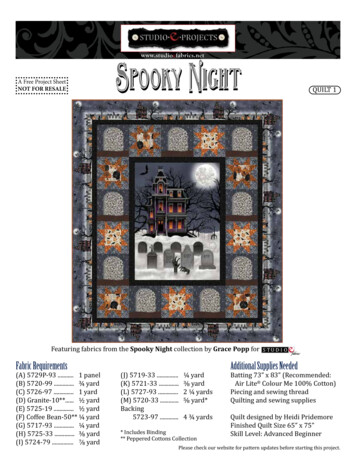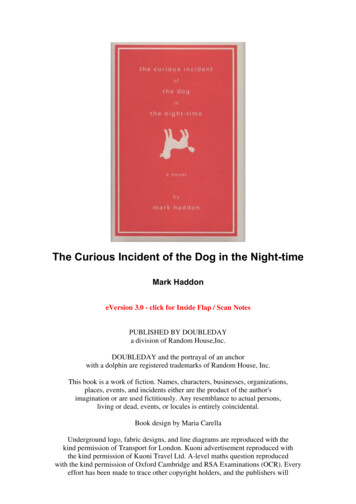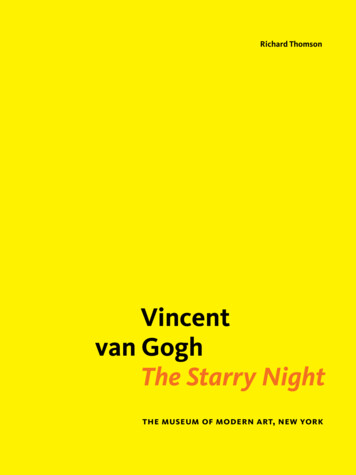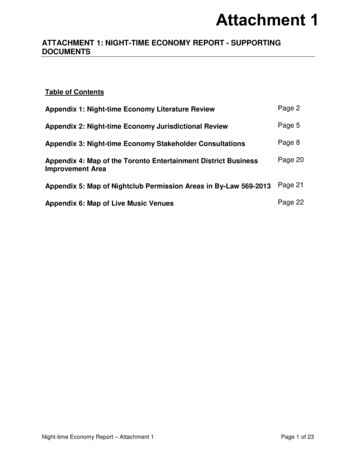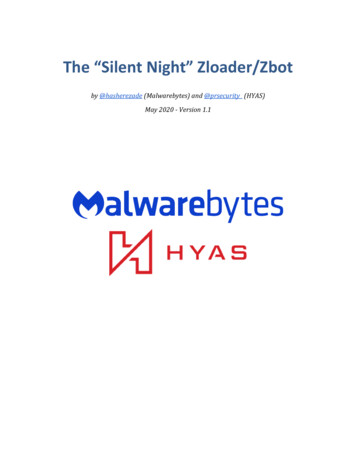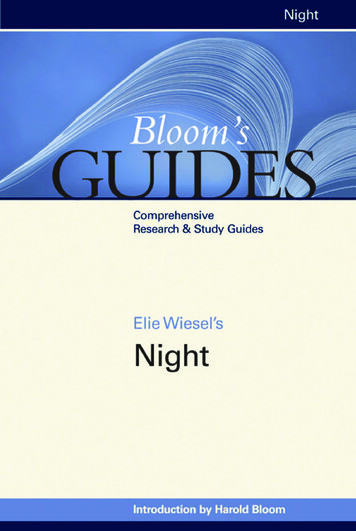
Transcription
Bloom’sGUIDESElie Wiesel’sNight
Currently AvailableThe Adventures ofHuckleberry FinnAll the Pretty HorsesAnimal FarmThe Autobiography of Malcolm XThe AwakeningThe Bell JarBelovedBeowulfBrave New WorldThe Canterbury TalesCatch-22The Catcher in the RyeThe ChosenThe CrucibleCry, the Beloved CountryDeath of a SalesmanFahrenheit 451FrankensteinThe Glass MenagerieThe Grapes of WrathGreat ExpectationsThe Great GatsbyHamletThe Handmaid’s TaleHeart of DarknessThe House on Mango StreetI Know Why the Caged Bird SingsThe IliadInvisible ManJane EyreThe Kite RunnerLord of the FliesMacbethMaggie: A Girl of the StreetsThe Member of the WeddingThe MetamorphosisNative SonNight1984The OdysseyOedipus RexOf Mice and MenOne Hundred Years of SolitudePride and PrejudiceRagtimeA Raisin in the SunThe Red Badge of CourageRomeo and JulietThe Scarlet LetterA Separate PeaceSlaughterhouse-FiveSnow Falling on CedarsThe StrangerA Streetcar Named DesireThe Sun Also RisesA Tale of Two CitiesThe Things They CarriedTo Kill a MockingbirdUncle Tom’s CabinThe Waste LandWuthering Heights
Bloom’sGUIDESElie Wiesel’sNightEdited & with an Introductionby Harold Bloom
Bloom’s Guides: NightCopyright 2009 by Infobase PublishingIntroduction 2009 by Harold BloomAll rights reserved. No part of this book may be reproduced or utilizedin any form or by any means, electronic or mechanical, includingphotocopying, recording, or by any information storage or retrievalsystems, without permission in writing from the publisher. Forinformation contact:Bloom’s Literary CriticismAn imprint of Infobase Publishing132 West 31st StreetNew York, NY 10001Library of Congress Cataloging-in-Publication DataElie Wiesel’s Night / [edited] by Harold Bloom.p. cm. — (Bloom’s guides)Includes bibliographical references and index.ISBN 978-1-60413-198-71. Wiesel, Elie, 1928– Nuit. 2. Authors, French—Biography—Historyand criticism. 3. Holocaust, Jewish (1939–1945), in literature. 4. Judaismand literature—France. I. Bloom, Harold.PQ2683.I32N8534 2009940.53’18071—dc222008037808Bloom’s Literary Criticism books are available at special discounts whenpurchased in bulk quantities for businesses, associations, institutions, orsales promotions. Please call our Special Sales Department in New Yorkat (212) 967-8800 or (800) 322-8755.You can find Bloom’s Literary Criticism on the World Wide Web athttp://www.chelseahouse.comContributing Editor: Neil HeimsCover design by Takeshi TakahashiPrinted in the United States of AmericaBang EJB 10 9 8 7 6 5 4 3 2 1This book is printed on acid-free paper.All links and Web addresses were checked and verified to be correct atthe time of publication. Because of the dynamic nature of the Web, someaddresses and links may have changed since publication and may nolonger be valid.
ContentsIntroductionBiographical SketchThe Story Behind the StoryList of CharactersSummary and AnalysisCritical ViewsAlfred Kazin Reviews the First Edition of the EnglishTranslationEllen S. Fine on Father-Son Relations in NightGary Henry on Transcendence in Wiesel’s WorkPeter Manseau on the Hazards of Holocaust TheologyJoseph Sungolowsky on Holocaust AutobiographySabine and Harry Stein on the History of BuchenwaldColin Davis on Wiesel’s Narrative TechniquesSimon P. Sibelman on the Role of Time in the BookOra Avni on Narrative and the Burden of WitnessRuth Franklin Re-evaluates NightWorks by Elie WieselAnnotated 215454586677889097101103107121123126128130
IntroductionHarold BloomRather than comment directly upon Elie Wiesel’s Night, whichis the subject of all the essays in this volume, I will addressmyself to the larger question of Holocaust literature. Mystarting point will be Geoffrey Hartman’s poignant and brilliantThe Longest Shadow: In the Aftermath of the Holocaust (1996).Trauma, primary and secondary, respectively that of survivor orof audience, is at the center of Hartman’s insights:I am hardly the first to worry about the increasingprevalence of psychic numbing accompanied byfascination, and which is usually the consequence ofprimary trauma. It would be ironic and sad if all thateducation could achieve were to transmit a trauma to latergenerations in secondary form. In this fifth decade afterthe collapse of the National Socialist regime, the disasterstill has not run its course. No closure is in sight: thecontradictory imperatives of remembering and forgettingare no less strong than before.But that leads to the question of artistic representation: canyou, should you, try to transmute the Holocaust into literature?Hartman defends the possibility of this transmutation againstthe Frankfurt Jewish philosopher, Theodor Adorno:After the Holocaust there is a spiritual hunt to deaestheticize everything—politics and culture as well asart. As Adorno phrased in his harshest and most famousstatement, it is a sign of the barbaric (that is, of lack ofculture) to write poetry after Auschwitz. He refused thearts a role even in mourning the destruction, becausethey might stylize it too much, or “make unthinkablefate appear to have some meaning.” Yet art creates
an unreality effect in a way that is not alienating ordesensitizing. At best, it also provides something of asafe-house for emotion and empathy. The tears we shed,like those of Aeneas when he sees the destruction of Troydepicted on the walls of Carthage, are an acknowledgmentand not an exploitation of the past.To acknowledge without exploiting is a difficult burden:are any of us strong enough for that? Hartman crucially goeson to consider a great poet, Paul Celan, Romanian-Jewish bybirth, who wrote in a purified German. Celan’s parents weremurdered in the Holocaust; the poet himself survived a laborcamp, but killed himself in Paris, at the age of fifty. His art wasone of reticence, stripping words of their images. Hartmanagain is precise and eloquent upon the effect:Trauma is given a form and disappears into the stammerwe call poetry, into a fissure between speech on the page,seemingly so absolute, and an invisible writing that maynot be retrievable. This is, in truth, a disaster notation.Paul Celan was a great (and very difficult) literary artist. ElieWiesel is an eminent Witness, but hardly a canonical writerof narrative. Yet only a moral idiot would react to Wiesel’sNight by refusing the burden of secondary trauma. A purelyaesthetic reaction to Night is impossible, and not to be urgedupon anyone. There remains what I find most problematicalfor Wiesel’s reader: How to find the strength to acknowledgeNight without exploiting it?
Biographical SketchElie Wiesel was born in the village of Sighet, in Transylvania,on September 20, 1928. Under Romanian control during mostof Wiesel’s youth, governance was transferred to Hungaryin 1940. On May 16, 1944, deportation of the Jews of Sighetto the Nazi death camp Auschwitz in Poland began. Wiesel,his father, mother, and three sisters were sent there. Hismother and younger sister were immediately killed. Wieseland his father remained together in Auschwitz in its slave-laborsection, Buna, throughout their incarceration. His father diedof dysentery in Buchenwald approximately two months beforethe arrival of American armed forces and the liberation of thecamp. After the liberation, unable to secure permission to settlein Palestine and not wishing to go back to Sighet, which wasthen occupied by troops of the Soviet Army, Wiesel was placedin an orphanage in France.Until the disruption of his life by the Nazis, Wiesel had leda typical, middle-class life. His family was loving, cultured,prosperous, close-knit, well regarded in the community, andOrthodox. His father, Shlomo, was a grocer and one of thevillage elders, a leader in the Jewish community. He encouragedhis son to study modern Hebrew—the Jews in Sighet spokeYiddish—science, and Freudian psychology. Wiesel’s mother,Sarah, was the daughter of a farmer and Hasid, a followerof a branch of mystical, Orthodox Judaism. She encouragedher son’s study of Torah, the Hebrew scriptures; the Talmud,the compendium of Jewish law; and Kabbalah, the mysticalJewish study of the divine particularly in its aspect as an indwelling force. Young Elie was a devout and scholarly boy witha passionate attachment to Judaism and a fiery belief in anddeep devotion to God.Sixteen years old at the time of his arrival in France, Wieselwas placed in an orphanage and was reunited with his two eldersisters, Hilda and Bea, who had also survived the concentrationcamps. In 1948, Wiesel began living in Paris and registeredat the Sorbonne where he studied literature, philosophy, and
psychology. To earn money, he taught Hebrew. At this time,too, he began a career in journalism, writing for the FrenchJewish paper, L’Arche, and for Yediot Ahronot, the newspaper ofthe Irgun, a Jewish group in Palestine dedicated to the creationof a Zionist state there. He came in contact with Irgun when hewas on a newspaper assignment in Tel Aviv.It was in his role as a journalist in 1954 or 1955 (the exactdate is uncertain) that Wiesel met the French Catholic writerand winner of the 1952 Nobel Prize in literature, FrançoisMauriac. During the course of the interview, Wiesel becameupset by Mauriac’s repeated references to the suffering inherentin the crucifixion and related some of the sufferings he had bothwitnessed and experienced in Auschwitz. In response, Mauriacwept at Wiesel’s revelations and encouraged him to write aboutwhat he had undergone, something Wiesel had been unableto do despite his career as a journalist. When Wiesel beganto relive his time in Auschwitz in writing, he produced a bookof nearly eight hundred pages, written in Yiddish, publishedin Argentina by a Yiddish publishing house, and called Undi velt hot geshvign (And the World Remained Silent). While inNew York, in 1956, covering the United Nations for a Frenchnewspaper, Wiesel was hit by a car and suffered serious injurythat required a ten-hour operation and an extended hospitalstay. Unable to return to France because of his injuries andunable to renew the French visa on which he traveled as astateless person, Wiesel applied for U.S. citizenship. He alsoset to work on transforming Un di velt hot geshvign. He cutthe book down to a little more than one hundred pages andrewrote it in French. La Nuit was published in 1958, and itsEnglish translation appeared two years later.Not an immediate popular success, nevertheless, in thecourse of a few years, Night became viewed as the mainaccount of the Holocaust and Wiesel became, in his person,the foremost voice of the experience of the Holocaust. From1972 to 1976, Wiesel served as a Distinguished Professorof Judaic Studies at the City University of New York. In1978, he was appointed Andrew Mellon Professor of theHumanities at Boston University. In 1982, Wiesel became the10
first Henry Luce Visiting Scholar in Humanities and SocialThought at Yale University. In 1978, then U.S. presidentJimmy Carter appointed Wiesel to head the U.S. HolocaustMemorial Council, which he did until 1986. In 1985, whenRonald Reagan, president at the time, awarded Wiesel theCongressional Gold Medal, Wiesel implored the president notto make a planned ceremonial visit to a cemetery in Bitburg,Germany, where SS men were buried, saying the president’splace was with the victims of the SS. Reagan, nevertheless,made the visit. In 1986, Wiesel was awarded the Nobel PeacePrize. From 1997 to 1999, he was Ingeborg Rennert VisitingProfessor of Judaic Studies at Barnard College.In 2002, Wiesel returned, for the first time since thedeportation, to Sighet where memorial status was conferredon the house in which he was born. He has been the recipientof numerous awards, has chaired many committees studyingaspects of the Holocaust, and has been a notable voice indefense of many groups of oppressed people. His ardentsupport for Israel, however, has caused some to regret whatthey see as his inability to weigh the suffering of Palestinians inthe conflict between Israel and Palestine.Wiesel has also consistently been the target of Holocaustdeniers, people who claim the Nazi program of Jewishextermination is a historical lie and that the Holocaust neverhappened. In 2007, he was attacked in an elevator in a hotelin San Francisco after addressing a conference there. Draggedfrom the elevator by a young man who intended to take himback to his room and make him confess that Night was acompendium of lies, Wiesel called for help and was rescued.Wiesel married Marion Erster Rose in 1969. She was bornin Austria and also survived incarceration in Nazi camps. Shehas served as translator for nearly all the books Wiesel wrote inFrench. They have a son, Shlomo Elisha Wiesel, named afterWiesel’s father.11
The Story Behind the StoryNight was written in part because Elie Wiesel, during aninterview for a newspaper article he was writing, chaffedat Nobel Prize–winning French Catholic writer FrançoisMauriac’s repeated references to the crucified Christ’ssufferings and responded by recounting some of the agonies heexperienced and witnessed at Auschwitz. To his credit, Mauriacdid not counter Wiesel’s outburst and attempt to explain whatChrist’s passion signified to him and its applicability to Jewishsuffering. Rather, he wept with Wiesel and encouraged him towrite about what he had gone through.Wiesel had already drawn up an outline for such an accountin April 1945, following his liberation from Buchenwald, whenhe was hospitalized with food poisoning and on the brink ofdeath. Wiesel had determinedly held back from writing such abook until Mauriac’s encouragement. Then, after his encounterwith Mauriac, on a trip to Argentina from France, Wiesel wroteUn di velt hot geshvign (And the World Remained Silent) a work ofnearly eight hundred pages written in Yiddish. The book wasproduced by a Yiddish publishing house in Argentina in 1956.Its release garnered little attention.In New York, covering
This book is printed on acid-free paper. All links and Web addresses were checked and verified to be correct at the time of publication. Because of the dynamic nature of the Web, some addresses and links may have changed since publication and may no longer be valid. Contents Introduction 7 Biographical Sketch 9 The Story Behind the Story 12 List of Characters 16 Summary and Analysis 21 .
